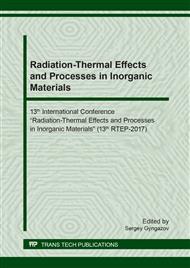[1]
E.E. Kornienko, E.J. Lapushkina, V.I. Kuzmin, S.P. Vaschenko, I.P. Gulyaev, E.V. Kartaev, D.S. Sergachev, N. Kashapov, S. Sharifullin, I. Fayrushin, Air plasma sprayed coatings of self-fluxing powder materials, Journal of Physics: Conference Series 567 (2014).
DOI: 10.1088/1742-6596/567/1/012010
Google Scholar
[2]
V.F. Myshkin, E.V. Bespala, V.A. Khan, S.V. Makarevich, Laws of the oxidation of carbon isotopes in plasma processes under magnetic field, IOP Conference Series: Materials Science and Engineering 135 (2016) 012029.
DOI: 10.1088/1757-899x/135/1/012029
Google Scholar
[3]
G. Gupta, A. Satapathy, Erosive wear characteristics of plasma-sprayed coatings of glass microspheres premixed with TiO2 particles, Tribology Transactions 59 (2016) 80–88.
DOI: 10.1080/10402004.2015.1045648
Google Scholar
[4]
V.F. Myshkin, V.A. Khan, V.G. Plekhanov, D.A. Izhoykin, E.V. Bespala, Spin Isotope Separation Under Incomplete Carbon Oxidation in a Low-Temperature Plasma in an External Magnetic Field, Russian Physics Journal 57 (2015) 1442–1448.
DOI: 10.1007/s11182-015-0401-4
Google Scholar
[5]
A.S. Zhukov, V.A. Arkhipov, S.S. Bondarchuk, V.D. Gol'din, Evaluation of the morphology of particles produced by plasma-chemical synthesis of ceramic powders, Rus. J. Phys. Chem., 7 (2013) 777–782.
DOI: 10.1134/s199079311306016x
Google Scholar
[6]
L. Huidong, S. Qi, W. Baodong, W. Peipei, Z. Jianhua, Morphology and Composition of Microspheres in Fly Ash from the Luohuang Power Plant, Chongqing, Southwestern China Minerals 6 (2016) 30.
DOI: 10.3390/min6020030
Google Scholar
[7]
E.V. Fomenko, N.N. Anshits, N.G. Vasil'eva, E.S. Rogovenko, O.A. Mikhaylova, E.V. Mazurova, L.A. Solovyev, A.G. Anshits, Composition and structure of the shells of aluminosilicate microspheres in fly ash formed on the combustion of Ekibastuz coal, Solid Fuel. Chem. 50 (2016).
DOI: 10.3103/s0361521916040030
Google Scholar
[8]
O.G. Volokitin, M.A. Sheremet, V.V. Shekhovtsov, N.S. Bondareva, V.I. Kuzmin, Studying regimes of convective heat transfer in the production of high-temperature silicate melts, Thermophys. Aeromech. 23 (2016) 755–765.
DOI: 10.1134/s0869864316050140
Google Scholar
[9]
A.R. Bogomolov, E.Yu. Temnikova, S.A. Shevyrev, A.V. Poltavets, A.S. Sysolyatin, Prospects of Using Fly Ash Produced at Kemerovo State District Power Station, MATEC Web of Conferences 37 (2015) 01010.
DOI: 10.1051/matecconf/20153701010
Google Scholar
[10]
A.S. Sysolyatin, I.A. Zvingul, E.Yu. Temnikova, Analysis of Fractionated Fly Ash and Slag at Kemerovo State District Power Plant, MATEC Web of Conferences 72 (2016) 01137.
DOI: 10.1051/matecconf/20167201137
Google Scholar
[11]
D.V. Dudina, S.B. Zlobin, N.V. Bulina, A.L. Bychkov, V.N. Korolyuk, V.Yu. Ulianitsky, O.I. Lomovsky, Detonation spraying of TiO2-2.5vol.%Ag powders in a reducing atmosphere, J. Eur. Ceram. Soc. 32 (2012) 815-821.
DOI: 10.1016/j.jeurceramsoc.2011.10.022
Google Scholar
[12]
O.P. Solonenko, I.P. Gulyaev, A.V. Smirnov, Thermal Plasma Processes for Production of Hollow Spherical Powders: Theory and Experiment, J. Therm. Sci. Tech. 2 (2011) 219–234.
DOI: 10.1299/jtst.6.219
Google Scholar
[13]
V.V. Shekhovtsov, O.G. Volokitin, A.A. Kondratyuk, R. E. Vitske, Fly ash particles spheroidization using low temperature plasma energy, IOP Conf. Series: Materials Science and Engineering 156 (2016) 012043.
DOI: 10.1088/1757-899x/156/1/012043
Google Scholar
[14]
V.V. Shekhovtsov, G.G. Volokitin, N.K. Skripnikova, О.G. Volokitin, R.E. Gafarov, Plasma treatment of agglomerating aluminosilicate powders based on coal ash, AIP Conference Proceedings 1800 (2017) 020008.
DOI: 10.1063/1.4973024
Google Scholar
[15]
V. Shekhovtsov, O. Volokitin, N. Tsetkov, G. Volokitin, N. Skripnikova, Aluminosilicate Microsphere Synthesis in Plasma Flow, Materials Science Forum 906 (2017) 131-136.
DOI: 10.4028/www.scientific.net/msf.906.131
Google Scholar


